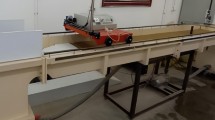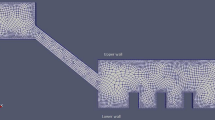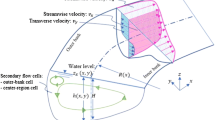Abstract
Free-surface flows over patchy vegetation are common in aquatic environments. In this study, the hydrodynamics of free-surface flow in a rectangular channel with a bed of rigid vegetation-like cylinders occupying half of the channel bed was investigated and interpreted by means of laboratory experiments and numerical simulations. The channel configurations have low width-to-depth aspect ratio (1.235 and 2.153). Experimental results show that the adjustment length for the flow to be fully developed through the vegetation patch in the present study is shorter than observed for large-aspect-ratio channels in other studies. Outside the lateral edge of the vegetation patch, negative velocity gradient (\(\partial \overline{u}/\partial z < 0\)) and a local velocity maximum are observed in the vertical profile of the longitudinal velocity in the near-bed region, corresponding to the negative Reynolds stress (\(- \overline{{u^{\prime}w^{\prime}}} < 0\)) at the same location. Assuming coherent vortices to be the dominant factor influencing the mean flow field, an improved Spalart–Allmaras turbulence model is developed. The model improvement is based on an enhanced turbulence length scale accounting for coherent vortices due to the effect of the porous vegetation canopy and channel bed. This particular flow characteristic is more profound in the case of high vegetation density due to the stronger momentum exchange of horizontal coherent vortices. Numerical simulations confirmed the local maximum velocity and negative gradient in the velocity profile due to the presence of vegetation and bed friction. This in turn supports the physical interpretation of the flow processes in the partly obstructed channel with vegetation patch. In addition, the vertical profile of the longitudinal velocity can also be explained by the vertical behavior of the horizontal coherent vortices based on a theoretical argument.















Similar content being viewed by others
Abbreviations
- a :
-
Frontal area per unit volume
- b e :
-
Effective width of stem
- b v :
-
Width of vegetation patch
- C d :
-
Drag coefficient of stems
- D :
-
Flow depth at the leading edge
- F i (F x , F y , F z ):
-
Drag force components in longitudinal, transverse, and vertical directions
- g :
-
Gravitational acceleration
- H w :
-
Side-wall height of flume
- h v :
-
Height of vegetation patch
- d :
-
Diameter of cylindrical vegetation element
- k :
-
Turbulent kinematic energy
- L :
-
Entire length of studied flume
- L d :
-
Length of downstream reach after vegetation patch
- L p :
-
Length of vegetation patch
- L t :
-
Apparent turbulence length scale of eddies
- L u :
-
Length of upstream reach before vegetation patch
- L y :
-
Turbulence length scale of eddies in transverse direction
- L z :
-
Turbulence length scale of eddies in vertical direction
- n :
-
Vegetation density, defined as number of vegetation elements per unit area
- p :
-
Instantaneous pressure
- Re d :
-
Cylinder-related Reynolds number
- Re D :
-
Depth-related Reynolds number
- s :
-
Spacing between vegetation elements
- S 0 :
-
Bed slope of flume
- t :
-
Time
- U :
-
Time-averaged longitudinal velocity
- U av :
-
Cross-sectional averaged velocity at leading edge
- u i (u, v, w):
-
Instantaneous velocity components in longitudinal, transverse, and vertical directions
- \(- \overline{{u^{\prime}v^{\prime}}}\) :
-
Longitudinal Reynolds stress associated with transverse momentum exchange
- \(- \overline{{u^{\prime}w^{\prime}}}\) :
-
Longitudinal Reynolds stress associated with vertical momentum exchange
- W :
-
Width of flume
- x a :
-
Flow adjustment length in longitudinal direction
- x i (x, y, z):
-
Local orthogonal coordinate system in longitudinal, transverse, and vertical directions
- y 0 :
-
Boundary of transverse coherent vortices in neighboring open water region
- y*:
-
Boundary of transverse coherent vortices in vegetation region
- z 0 :
-
Outer boundary of vertical coherent vortices
- z s :
-
Viscous sublayer thickness
- \(\delta_{ij}\) :
-
Kronecker delta
- δ y :
-
Integral length scale of transverse coherent vortices
- δ z :
-
Integral length scale of vertical coherent vortices
- α, β :
-
Coefficients adjusting the distribution function of the turbulence length scale of eddies
- κ :
-
Karman coefficient
- \(\nu_{\text{m}}\) :
-
Molecular viscosity
- \(\nu_{\text{t}}\) :
-
Turbulent viscosity
- ρ :
-
Water density
- \(\varsigma\) :
-
New viscosity variable introduced in Spalart–Allmaras model
- c b1, c b2, c v1, c w1, c w2, c w3, f v1, f v2, f w , r, \(S_{v}\), \(\psi_{v}\), χ, σ :
-
Coefficients to resolve the turbulent viscosity equation
References
Belcher SE, Jerram N, Hunt JCR (2003) Adjustment of a turbulent boundary layer to a canopy of roughness elements. J Fluid Mech 488:369–398
Chanson H, Trevethan M, Koch C (2007) Discussion of “Turbulence measurements with acoustic Doppler velocimeters” by Carlos M. García, Mariano I. Cantero, Yarko Niño, and Marcelo H. García. J Hydraul Eng 133:1286–1289
Chen Z, Ortiz A, Zong L, Nepf H (2012) The wake structure behind a porous obstruction and its implications for deposition near a finite patch of emergent vegetation. Water Resour Res 48(9). doi:10.1029/2012WR012224
Cheng NS (2013) Calculation of drag coefficient for arrays of emergent circular cylinders with pseudofluid model. J Hydraul Eng 139:602–611
Choi S-U, Kang H (2006) Numerical investigations of mean flow and turbulence structures of partly-vegetated open-channel flows using the Reynolds stress model. J Hydraul Res 44:203–217
Chu V, Wu J-H, Khayat R (1991) Stability of transverse shear flows in shallow open channels. J Hydraul Eng 117:1370–1388
Craig RG, Loadman C, Clement B, Rusello PJ et al. (2011) Characterization and testing of a new bistatic profiling acoustic doppler velocimeter: The vectrino-II. In: IEEE/OES 10th conference on current, waves and turbulence measurements (CWTM), p 246–252
Ghisalberti M (2002) Mixing layers and coherent structures in vegetated aquatic flows. J Geophys Res 107(C2):1–3
Hu Y, Huai W, Han J (2013) Analytical solution for vertical profile of streamwise velocity in open-channel flow with submerged vegetation. Environ Fluid Mech 13:389–402
Huai W, Xu Z, Yang Z, Zeng Y (2008) Two dimensional analytical solution for a partially vegetated compound channel flow. Appl Math Mech 29:1077–1084
Huai W, Xue W, Qian Z (2015) Large-eddy simulation of turbulent rectangular open-channel flow with an emergent rigid vegetation patch. Adv Water Resour 80:30–42
Li C, Xie J (2011) Numerical modeling of free surface flow over submerged and highly flexible vegetation. Adv Water Resour 34:468–477
Li CW, Zeng C (2009) 3D numerical modelling of flow divisions at open channel junctions with or without vegetation. Adv Water Resour 32:49–60
Lima AC, Izumi N (2014) On the nonlinear development of shear layers in partially vegetated channels. Phys Fluids 26:084109
Lin P, Li CW (2002) A σ-coordinate three-dimensional numerical model for surface wave propagation. Int J Numer Meth Fluids 38:1045–1068
Liu Z, Chen Y, Zhu D, Hui E et al (2012) Analytical model for vertical velocity profiles in flows with submerged shrub-like vegetation. Environ Fluid Mech 12:341–346
Luhar M, Rominger J, Nepf H (2008) Interaction between flow, transport and vegetation spatial structure. Environ Fluid Mech 8:423–439
Meftah MB, De Serio F, Mossa M (2014) Hydrodynamic behavior in the outer shear layer of partly obstructed open channels. Phys Fluids (1994-present) 26:065102
Moltchanov S, Bohbot-Raviv Y, Shavit U (2011) Dispersive stresses at the canopy upstream edge. Bound-Layer Meteorol 139:333–351
Nepf HM (2012) Hydrodynamics of vegetated channels. J Hydraul Res 50:262–279
Nezu I, Nakagawa H (1993) Turbulence in open channel flows, IAHR. Balkema, Rotterdam
Nezu I, Onitsuka K (2001) Turbulent structures in partly vegetated open-channel flows with LDA and PI V measurements. J Hydraul Res 39:629–642
Poggi D, Porporato A, Ridolfi L, Albertson J et al (2004) The effect of vegetation density on canopy sub-layer turbulence. Bound-Layer Meteorol 111:565–587
Pope SB (2000) Turbulent flows. Cambridge University Press, Cambridge
Raupach MR, Finnigan J, Brunei Y (1996) Coherent eddies and turbulence in vegetation canopies: the mixing-layer analogy. Bound-Layer Meteorol 78:351–382
Rominger JT, Nepf HM (2011) Flow adjustment and interior flow associated with a rectangular porous obstruction. J Fluid Mech 680:636–659
Shimizu Y, Tsujimoto T (1993) Comparison of flood flow structure between compound channel and channel with vegetation zone. In: Proceedings of 25th IAHR Congress, Delft, The Netherlands
Simpson RL, Good RE, Walker R, Frasco BR (1983) The role of Delaware River freshwater tidal wetlands in the retention of nutrients and heavy metals. J Environ Qual 12:41–48
Spalart PR, Allmaras SR (1992) A one-equation turbulence model for aerodynamic flows. 30th Aerospace Sciences Meeting and Exhibit, Aerospace Sciences Meetings
Stoesser T, Neary V, Wilson C (2005) Modeling vegetated channel flows: challenges and opportunities In: WSEAS (The World Scientific and Engineering Academy and Society) conference on fluid mechanics, Corfu, Greece
Sweeney BW, Bott TL, Jackson JK, Kaplan LA et al (2004) Riparian deforestation, stream narrowing, and loss of stream ecosystem services. Proc Natl Acad Sci USA 101:14132–14137
Tang X, Knight D, Sterling M (2011) Analytical model for streamwise velocity in vegetated channels. Proc ICE-Eng Comput Mech 164:91–102
Tanino Y, Nepf HM (2008) Laboratory investigation of mean drag in a random array of rigid, emergent cylinders. J Hydraul Eng 134:34–41
Tsujimoto T, Kitamura T (1992) Appearance of organized fluctuations in open channel flow with vegetated zone. KHL Progressive Report, 37–45 Hydraulics Laboratory, Kanazawa University, Kanazawa, Japan
White BL, Nepf HM (2007) Shear instability and coherent structures in shallow flow adjacent to a porous layer. J Fluid Mech 593:1–32
White BL, Nepf HM (2008) A vortex-based model of velocity and shear stress in a partially vegetated shallow channel. Water Resour Res 44(1). doi:10.1029/2006WR005651
Windham L, Weis J, Weis P (2003) Uptake and distribution of metals in two dominant salt marsh macrophytes, Spartina alterniflora (cordgrass) and Phragmites australis (common reed). Estuar Coast Shelf Sci 56:63–72
Wu W, He Z (2009) Effects of vegetation on flow conveyance and sediment transport capacity. Int J Sediment Res 24:247–259
Xiaohui S, Li C (2002) Large eddy simulation of free surface turbulent flow in partly vegetated open channels. Int J Numer Meth Fluids 39:919–937
Zedel L, Hay A (2011) Turbulence measurements in a jet: comparing the vectrino and vectrino-II. In: IEEE/OES 10th conference on current, waves and turbulence measurements (CWTM), pp 173–178
Zeng C, Li CW (2012) Modeling flows over gravel beds by a drag force method and a modified S-A turbulence closure. Adv Water Resour 46:84–95
Zeng C, Li CW (2013) Measurements and modeling of open-channel flows with finite semi-rigid vegetation patches. Environ Fluid Mech 14:113–134
Acknowledgments
The research was funded by the Central Research Grants of The Hong Kong Polytechnic University. It was also partly supported by Research Grants Council General Research Fund (PolyU 5273/12E) and Environmental and Conservation Fund (ECF39/2011).
Author information
Authors and Affiliations
Corresponding author
Appendix
Appendix
On the nonvegetated side, the bed shear stress is balanced by the Reynolds stress. On the vegetated side, the bed shear stress is balanced by the Reynolds stress and the stem drag force.
1.1 Nonvegetated side
Assuming the mixing length theory to be valid,
With algebraic manipulations and integrations,
where z s is the viscous sublayer thickness.
At the near-bed region, horizontal coherent vortices are absent due to the bed friction, and we have \(- \partial \overline{{u^{\prime}v^{\prime}}}/\partial y \approx 0.\) Therefore,
As the distance from the bed increases, the horizontal coherent vortices are triggered by the flow shear, and we have \(- \partial \overline{{u^{\prime}v^{\prime}}}/\partial y < 0\). Therefore,
Nonvegetated side
Assuming the mixing length theory to be valid,
With algebraic manipulations and integrations,
At the near-bed region, the horizontal coherent vortices are absent due to bed friction, and we have \(- \partial \overline{{u^{\prime}v^{\prime}}}/\partial y \approx 0\). Therefore,
As the distance from the bed increases, the horizontal coherent vortices are triggered by the flow shear, and we have \(- \partial \overline{{u^{\prime}v^{\prime}}}/\partial y > 0\). Therefore,
Rights and permissions
About this article
Cite this article
Yan, XF., Wai, WH.O. & Li, CW. Characteristics of flow structure of free-surface flow in a partly obstructed open channel with vegetation patch. Environ Fluid Mech 16, 807–832 (2016). https://doi.org/10.1007/s10652-016-9453-4
Received:
Accepted:
Published:
Issue Date:
DOI: https://doi.org/10.1007/s10652-016-9453-4




